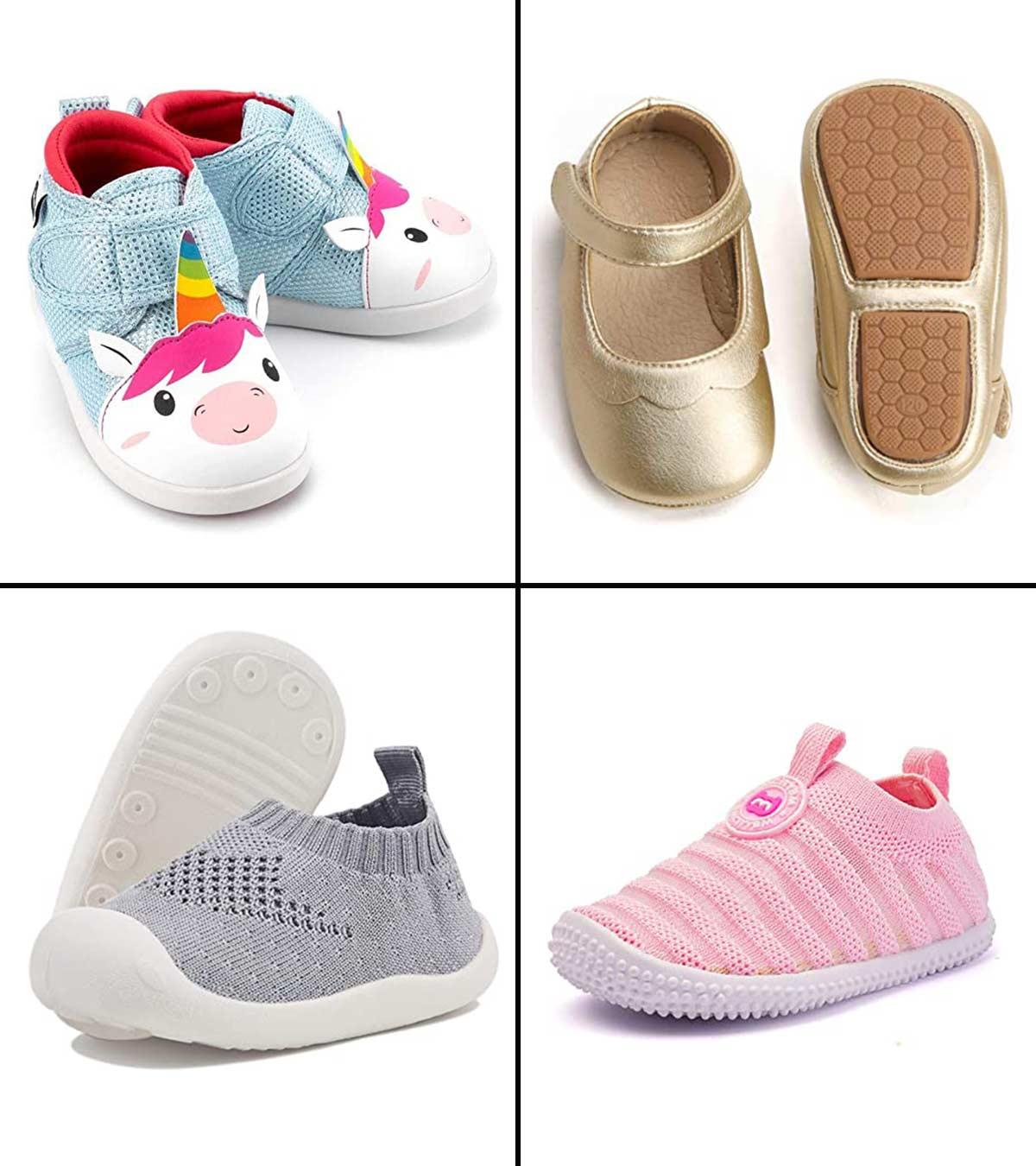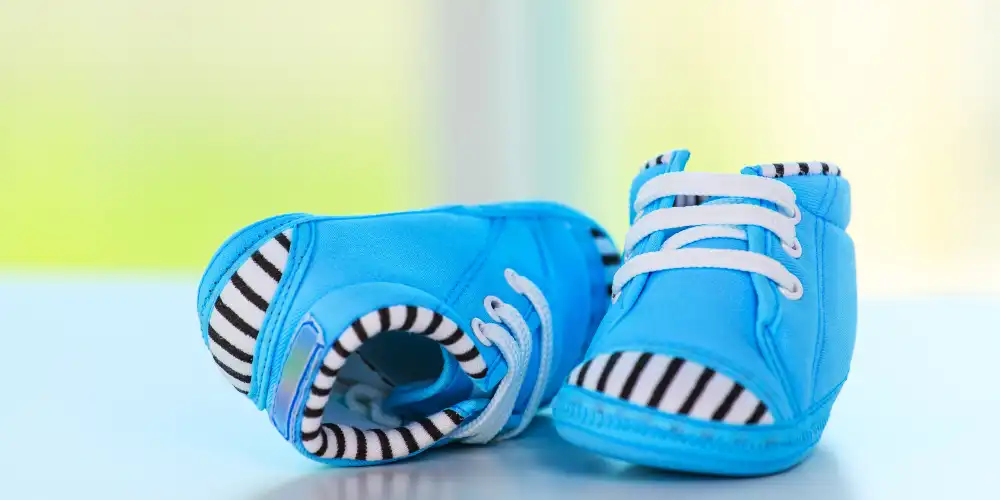The best baby shoes for new walkers are those that offer support and flexibility. Soft-soled, non-slip shoes are ideal for growing feet.

Credit: www.amazon.com
Choosing The Right Shoes
As your little one takes their first steps, the choice of shoes becomes a pinnacle in fostering safe and confident walking. This section delves into the essentials of selecting the right shoes for new walkers.
Importance Of Proper Footwear
Proper footwear is crucial for developing feet. The right shoes provide support, flexibility, and protection while encouraging natural foot movement.
A conducive environment for growth is essential. Shoes that fit well prevent injuries and improper walking habits. The goal is to mimic barefoot conditions as closely as possible.
Factors To Consider
- Size: Ensure a snug fit with room for toes.
- Material: Breathable, natural fabrics are best.
- Soles: Go for non-slip and thin, flexible soles.
- Fastenings: Shoes should stay on securely without constricting.
- Shape: Look for a wide toe box for movement.
- Flat: Avoid heels to promote natural walking.
Consider seasonal needs too. Go for warm options in winter and airy ones in summer. Always measure your baby’s feet as they grow fast.
| Age | Foot Length (inches) | Shoe Size (US) |
|---|---|---|
| 9-12 months | 4.5 – 4.75 | 3-4 |
| 12-18 months | 4.75 – 5.25 | 5-6 |
| 18-24 months | 5.25 – 5.5 | 6-8 |
Remember, each child is unique. While the table offers a general guide, always measure before you buy.

Credit: carriageboutique.com
Developmental Stage And Shoe Types
Choosing the right shoes for your baby matters a lot. As tiny feet start their journey, the proper footwear supports healthy foot development. Let’s explore shoe types for different stages of your little one’s walking adventure.
Prewalkers
Babies exploring the ground on all fours need soft, comfortable shoes. These flexible soles allow natural foot movement. Think of them more as cozy coverings than shoes.
- Crawling stage shoe qualities: Softness, flexibility, and non-constricting design
- Materials: Soft leather, cloth, or canvas
Early Walkers
Stability and support are key for babies who are just starting to stand and take their first steps. Seek out shoes with non-slip soles and a secure fit to encourage confidence.
Shoe features should include:
| Shoe Feature | Benefits |
|---|---|
| Ankle Support | Helps with balance |
| Adjustable Closures | Ensures snug fit |
| Flexible Soles | Promotes natural foot movement |
Confident Walkers
Once a child walks without help, it’s time for more structured shoes. Look for durable soles that handle varied surfaces, making exploration safe and fun.
- Soles should offer grip but still allow for easy movement
- Construction should be sturdy, protecting little feet
- Breathability keeps feet fresh during active play
Support And Stability
As little ones take their first steps, support and stability are key. The right baby shoes will set a foundation for healthy walking habits. Let’s explore features that blend comfort with the right structure for wobbly new walkers.
Cushioned Soles
Soft, padded soles make each step a joy for those tiny feet. Thick cushioning absorbs impact and provides a plush surface. It’s like walking on tiny clouds! This protects tender soles during those adventurous first steps.
- Memory foam insoles adapt to little foot shapes.
- Midsole cushioning reduces pressure on small feet.
- Soft materials prevent irritation for comfort all day.
Ankle Support
Shoes with proper ankle support give babies the confidence to stand and move. Sturdy ankle collars keep feet steady and secure. Look for shoes that offer support without restricting movements:
| Feature | Benefit |
|---|---|
| High-top design | Stabilizes the ankle area |
| Velcro straps or elastic laces | Ensure a snug fit without being too tight |
| Padded collars | Add comfort and extra support |
Flexible Outsoles
Baby shoes must bend with the natural movement of tiny toes. Flexible outsoles enable natural foot motion. This is crucial for developing coordination and balance. Shoes that mimic barefoot walking are often best:
- Look for thin outsoles that twist easily.
- Materials like rubber and soft leather offer flexibility and grip.
- Avoid stiff or thick soles that can trip up new walkers.

Credit: www.momjunction.com
Sizing And Fit
The right size and fit are crucial for your baby’s comfort and foot development. Ensuring the shoes you pick are a perfect match for those tiny feet will allow your little one to explore the world confidently on their new walking adventures. Let’s dive into how to measure, account for growth, and the importance of adjustable closures for those perfect first shoes.
Measuring Children’s Feet
Start with precise measurements for a solid foundation. Measure while your child is standing to get the most accurate size. Here’s a simple way to do it:
- Place your child’s foot on a sheet of paper.
- Mark the longest toe and the back of the heel.
- Use a ruler to measure the distance between the marks.
- Check against a size chart for the corresponding shoe size.
Allowing Room For Growth
Babies’ feet grow fast. Choose shoes that allow some room, about a thumb’s width from the longest toe to the shoe’s end. This space supports growth and helps in avoiding pressure or constriction.
Adjustable Closures
Look for shoes with adjustable closures like Velcro, laces, or snaps. These features help in achieving a snug, yet comfortable fit. Ensure closures are secure but not too tight to maintain flexibility and natural foot movement.
| Feature | Benefits |
|---|---|
| Room for Growth | Prevents constriction, allows for foot development. |
| Adjustable Closures | Ensures a snug fit, supports ease of motion. |
Material And Breathability
Choosing the right baby shoes for new walkers is essential. The material and breathability matter most. Little feet need shoes that feel comfortable and allow for healthy foot development.
Quality Materials
Baby shoes should use non-toxic, high-quality materials. Safe for delicate skin, these materials prevent irritation.
- Leather: Durable and molds to the foot.
- Cotton: Light and washable.
- Canvas: Sturdy for active play.
Shoes with flexible soles promote natural movement. A soft sole supports balance and coordination.
Breathable Fabrics
Baby shoes must breathe to keep feet fresh. New walkers need airflow to avoid sweaty feet.
| Fabric Type | Benefits |
|---|---|
| Mesh | Maximum breathability |
| Cotton | Soft and allows air to pass through |
| Canvas | Stays cool, lets moisture out |
Choose shoes that combine breathability with comfort. Shoes with breathable fabric linings offer extra comfort.
Durability And Traction
Choosing the right baby shoes for new walkers is crucial. Little ones need shoes that can stand up to their adventures and provide safe, stable footing. Let’s dive into why durable construction and non-slip soles are essential for your toddler’s first steps.
Durable Construction
The best baby shoes for new walkers boast sturdy materials and excellent craftsmanship. This ensures that shoes resist wear and tear as toddlers explore, climb, and run. Look for shoes with reinforced toes and high-quality seams.
Flexible soles that bend with your child’s feet are a plus. They offer protection while allowing for natural movement. Here are some key features for durable baby shoes:
- Leather or canvas uppers for resilience and breathability.
- Reinforced stitching to withstand constant motion.
- Padded collars for added comfort and support.
Non-slip Soles
Non-slip soles are a non-negotiable feature in baby shoes. Toddlers need secure grip on all surfaces to prevent slipping. Look for shoes with rubber soles featuring deep grooves or raised patterns.
These designs create friction and offer superior traction. Smooth, flat soles without grip can make walking risky. Ensure your toddler’s first steps are on solid ground with the right soles.
| Feature | Benefit |
|---|---|
| Textured Patterns | Enhances grip on various surfaces. |
| Flexible Rubber | Provides stability and comfort. |
| Heel and Toe Reinforcement | Adds durability where it’s needed most. |
Style And Design
Your little one’s first steps are a milestone. Stylish and functional shoes play a crucial role. The right pair combines fashion with comfort. It supports your baby’s journey from crawling to walking.
Attractive and Age-Appropriate Designs
Attractive And Age-appropriate Designs
Shoes for new walkers come in a variety of fun designs. Look for options that capture the essence of childhood. Bright colors and patterns can stimulate your little one’s senses. Whimsical shapes and characters can spark imagination.
- Bright and playful motifs
- Themes with animals or superheroes
- Soft hues for a gentle aesthetic
Easy to Put On and Take Off
Easy To Put On And Take Off
Practicality is key in baby shoes. Look for shoes that are simple to navigate. Velcro straps and elastic laces are ideal. They allow for a quick fit. This ensures your baby won’t get frustrated during dress-up. And neither will you!
| Feature | Benefit |
|---|---|
| Velcro straps | Adjustable, secure fit |
| Elastic laces | No need to tie |
| Slip-on | Effortless to put on |
Budget-friendly Options
Finding shoes for new walkers doesn’t mean breaking the bank. Parents can discover comfortable, supportive, and stylish options without spending a fortune. Affordable shoes can still offer the quality and features necessary for those first precious steps.
Affordable Brands
Renowned for cost-effective prices and durable materials, several brands make the cut for parents on a tight budget:
- Carter’s: A popular choice with cute designs.
- OshKosh B’Gosh: Offers playful shoes perfect for toddlers.
- Pediped Outlet: Known for anatomic support on a budget.
Value For Money
Selecting shoes that offer the best value for your investment is key. Look for these features to ensure you’re getting the best deal:
| Feature | Benefit |
|---|---|
| Non-Slip Soles | Prevent slips and falls |
| Flexible Material | Encourage natural foot movement |
| Adjustable Closure | Accommodate growing feet |
Frequently Asked Questions For Best Baby Shoes For New Walkers
What Shoes Do Babies Wear When They Start Walking?
Babies starting to walk typically wear soft-soled, non-skid shoes that promote natural foot movement and provide protection. Lightweight, flexible footwear with a roomy fit is ideal for developing feet.
Do Babies Need First Walker Shoes?
Babies typically do not need walker shoes until they are walking independently, often around 12–15 months. Going barefoot or wearing non-restrictive socks helps develop foot strength and coordination during the early stages.
How to Choose Shoes for Early Walkers?
Select flexible, non-skid soles for stability. Ensure a snug fit, avoiding tight or overly loose shoes. Opt for lightweight, breathable materials. Choose ankle support to promote proper balance. Always verify comfort by checking for adequate toe room.
Are Crocs Good For New Walkers?
Crocs are not ideal for new walkers. Their typically loose fit can interfere with the development of proper walking skills. It’s better to choose more secure, form-fitting shoes for young children learning to walk.
Conclusion
Selecting the perfect pair of baby shoes for new walkers is pivotal. It impacts both safety and comfort as they explore. Remember, breathable materials and flexible, non-slip soles are key. Trust in reputable brands that focus on development and style. Your little one’s first steps are precious—equip them with the best for a confident, happy start.

Hello! I’m Gobinda, the founder of this website. I’m a father to my growing child. I love the world of babies, so I started a blog about it. I want to share my fascination and help other parents.


